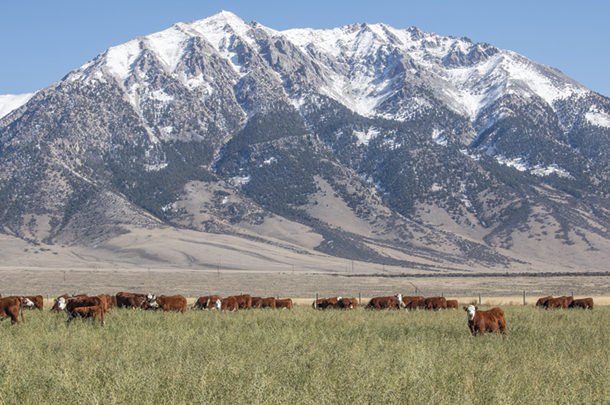I have known a wide variety of successful graziers, and they come at the challenge from many different perspectives and management approaches. One thing they all have in common is: They understand the delicate balance between feed supply and feed demand, they know how to use animal impact to improve the soil, and they make good decisions on their feet as they adapt to an ever-changing situation.
I was recently on a program at the American Plant Food Agronomic Productivity Forum on Forage Management in San Antonio, Texas. It was fun to be on the program with so many of my heroes. The speaker before me was Hugh Aljoe, director of producer relations with the Noble Research Institute. Aljoe talked about how managed grazing impacts the success of beef cattle grazing operations.
He told us that the three most critical grazing management issues he deals with are stocking rate, stocking rate and stocking rate. His point was that probably the most important factor in the success of our farms and ranches is how many animals we choose to place on our pasture resource. It is one of the few things we are completely in control of.
Aljoe got me thinking about the critical importance of this concept, so I thought I would explore it a little more. I’ll start by defining three important terms. First, “carrying capacity” is the number of animal units (A = 1,000 pounds of animal weight) the farm or ranch can sustain over the years without degrading the resource base. It is that balance between animal demand and forage production that we all seek.
“Stocking rate” is the number of animal units we decide to keep on the pastures. So if you have 40 1,250-pound cows and 100 acres of pasture, you are stocked at 1 AU per 2 acres or 0.5 AU (500 pounds) per acre.

The three most critical grazing management issues he deals with are stocking rate, stocking rate and stocking rate. Photo provided by Matt Poore.
Finally, “stocking density” is the number of animals or weight within the paddock where cattle are at the given moment. So if the 40 cows (50,000 pounds) rotate among 10 pastures of 10 acres each, the stocking density is 5,000 pounds per acre.
Now back to your most important decision and some of the complicating factors. One assumption we sometimes make is that the goal of all our systems is to not have to feed hay at all. This is a great goal and one that many farmers have, including myself. However, there are situations where there is too much snow, ice and mud in the winter to effectively graze, and there are also situations where harvested feed is available at a very low cost for purchase from outside the farm. In these situations, a planned winter feeding system will often be part of the management plan.
One popular program recently for beef producers in the Southeast has been “300 Days Grazing” which sets a 65-day winter feeding season as a goal. Whatever your situation, you need to understand that if the hay or other feed is coming from outside your fenced land, then it is not included in your stocking rate. As more and more feed is imported into a farm, the higher the chance of overgrazing and the need to have concentrated feeding sites.
At my personal farm, we have a plan to feed for 45 days in the fall and buy most of our hay. We really like unrolling it so we get the fertilizer nutrient benefit from that imported forage. We do have variation in our carrying capacity each year due to differences in growth, largely due to rainfall. So in a good year, we will have more grazing than we need to get through the winter.
Another complicating factor is: Stocking rate is an instantaneous measure, and it can and will vary over the year. On a cow-calf farm, as the calves gain weight, they eat more forage and their bodyweight needs to be accounted for in the stocking rate. When the calves are sold, the stocking rate drops abruptly, and that is an important consideration for farms stockpiling grass for winter grazing. In a stocker system, you can use this as a strategy to deal with seasonal forage production by stocking heavily in the beginning of the grazing season and selling part of the cattle when forage production is expected to decline.
While these seem to be fairly simple concepts, it has been difficult for me to convince many farmers that reducing their stocking rate to minimize the length of the hay feeding season is the best way to improve their system. It is critical to understand that as stocking rate approaches your carrying capacity, the cost of carrying an additional cow will dramatically jump. Essentially, you have to buy all the feed for every cow you have over your carrying capacity. Our typical 1,200-pound cow needs about 6 tons of medium-quality forage to get through a year, and in our area the cost of buying that forage would be at least $600.
Finally, stocking slightly below the carrying capacity and doing a base level of rotational grazing management is good for the soil and for our industry as a whole. When we avoid overgrazing, soil health will improve, and that will help us improve the infiltration of rainfall and to build soil carbon. Both of those are important “ecosystem services” that can be credited to good grazing managers. Healthy pastures and rangeland is good for everybody, and it is one of the best stories we have to tell the general public.
So as you start your grazing season this year, consider the concepts of carrying capacity, stocking rate and stocking density. Developing the “eye of the master” for the complex ecosystem starts with a clear understanding of these underlying principles.









